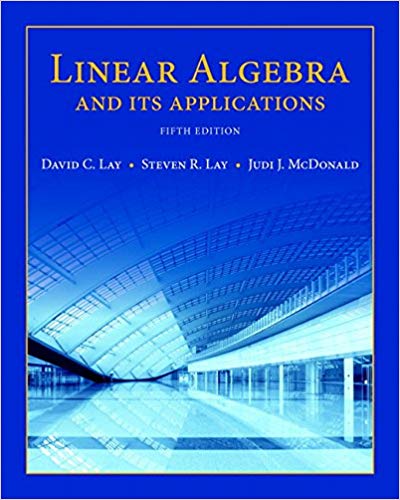
Linear Algebra and Its Applications, 5th Edition
Authors: David C. Lay, Steven R. Lay, Judi J. McDonald
ISBN-13: 978-0321982384
We have solutions for your book!
See our solution for Question 18E from Chapter 6.5 from Lay's Linear Algebra and Its Applications, 5th Edition.
Problem 18E
Chapter:
Problem:
Step-by-Step Solution
Given Information
We are given with some statements that we have to prove whether they are True or False.
Step-1: (a)
When b is in the Column space of A, then $b=Ax$ for some x, such that x is the least-square solution. Therefore,
The statement is True
Step-2: (b)
If x is the least-squares solution, then $Ax$ is the point in the column space of closest to $b$. Thus,
The statement is False
Step-3: (c)
If b is the orthogonal projection of b onto Col A, that is $Ax=b$. Hence the system Ax=b is consistent. By the definition of orthogonal decomposition, the projection $\widehat {\bf{b}}$ has the property that ${\bf{b}} - \widehat {\bf{b}}$ is orthogonal to Col A. Therefore,
The statement is True
Step-4: (d)
The matrix $A^TA$ is invertible if an only if the columns of A are linearly independent. Thus, the equation $Ax=b$ has only one least squares solution \[ \mathbf { x } = \left( A ^ { T } A \right) ^ { - 1 } A ^ { T } \mathbf { b } \] Thus,
The statement is False
Step-5: (e)
In the procedure of normal equations for a least squares solution, small errors in calculation of $A^TA$ can lead to relatively large errors in the solution $x$.
If the columns of A are linearly independent, the least squares solution can often be computed more reliably through QR factorization of A, Thus,
The statement is False
Step-6: (f)
When, a $m\times n$ matrix has linearly independent columns and M is the QR factorization of A, then $Ax=b$ has a unique solution for each b in $R^m$.
Since R is an upper triangular matrix, $x$ can be computed from: $R \mathbf { x } = Q ^ { T } \mathbf { b }$
Therefore,
The statement is False
We are given with some statements that we have to prove whether they are True or False.
Step-1: (a)
When b is in the Column space of A, then $b=Ax$ for some x, such that x is the least-square solution. Therefore,
The statement is True
Step-2: (b)
If x is the least-squares solution, then $Ax$ is the point in the column space of closest to $b$. Thus,
The statement is False
Step-3: (c)
If b is the orthogonal projection of b onto Col A, that is $Ax=b$. Hence the system Ax=b is consistent. By the definition of orthogonal decomposition, the projection $\widehat {\bf{b}}$ has the property that ${\bf{b}} - \widehat {\bf{b}}$ is orthogonal to Col A. Therefore,
The statement is True
Step-4: (d)
The matrix $A^TA$ is invertible if an only if the columns of A are linearly independent. Thus, the equation $Ax=b$ has only one least squares solution \[ \mathbf { x } = \left( A ^ { T } A \right) ^ { - 1 } A ^ { T } \mathbf { b } \] Thus,
The statement is False
Step-5: (e)
In the procedure of normal equations for a least squares solution, small errors in calculation of $A^TA$ can lead to relatively large errors in the solution $x$.
If the columns of A are linearly independent, the least squares solution can often be computed more reliably through QR factorization of A, Thus,
The statement is False
Step-6: (f)
When, a $m\times n$ matrix has linearly independent columns and M is the QR factorization of A, then $Ax=b$ has a unique solution for each b in $R^m$.
Since R is an upper triangular matrix, $x$ can be computed from: $R \mathbf { x } = Q ^ { T } \mathbf { b }$
Therefore,
The statement is False